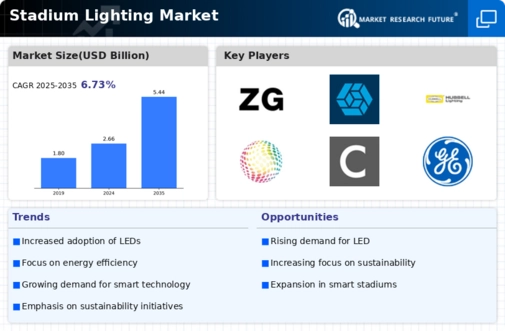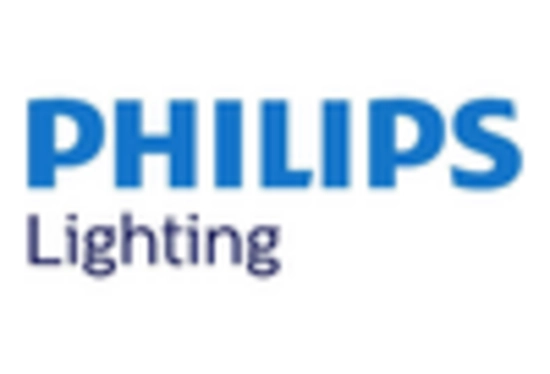Rising Popularity of Outdoor Events
The rising popularity of outdoor events is a significant driver for the Stadium Lighting Market. As more events are held in open-air venues, the demand for effective lighting solutions has surged. This trend is particularly evident in regions where outdoor sports and concerts are prevalent. The need for reliable lighting systems that can withstand various weather conditions is becoming increasingly important. Market analysis suggests that the outdoor event segment is expected to grow by approximately 10% annually, further fueling the demand for advanced lighting technologies. Consequently, the Stadium Lighting Market is likely to see a shift towards more robust and versatile lighting solutions that cater to the unique challenges posed by outdoor environments.
Growing Demand for Enhanced Visibility
The Stadium Lighting Market is experiencing a notable increase in demand for enhanced visibility during events. This trend is driven by the need for improved safety and spectator experience. As stadiums host a variety of events, including sports and concerts, the requirement for high-quality lighting becomes paramount. Recent data indicates that stadiums equipped with advanced lighting systems can enhance visibility by up to 30%, thereby improving the overall experience for attendees. Furthermore, the integration of LED technology has proven to be a game-changer, offering brighter illumination while reducing energy consumption. This shift towards superior visibility is likely to propel the Stadium Lighting Market forward, as stakeholders recognize the importance of creating an engaging atmosphere for fans and participants alike.
Regulatory Support for Sustainable Practices
The Stadium Lighting Market is benefiting from regulatory support aimed at promoting sustainable practices. Governments are increasingly implementing policies that encourage the adoption of energy-efficient lighting solutions. For example, initiatives that provide financial incentives for stadiums to upgrade to LED lighting systems are becoming more common. These regulations not only aim to reduce carbon footprints but also to lower operational costs for stadium operators. As a result, the market for energy-efficient lighting solutions is expected to expand, with projections indicating a potential increase in market size by 15% over the next five years. This regulatory environment is likely to foster innovation and investment within the Stadium Lighting Market.
Increased Investment in Sports Infrastructure
Increased investment in sports infrastructure is a pivotal factor driving the Stadium Lighting Market. As countries and organizations allocate funds to enhance their sports facilities, the demand for state-of-the-art lighting systems is on the rise. This investment trend is particularly pronounced in emerging markets, where new stadiums are being constructed to meet international standards. Recent reports indicate that The Stadium Lighting Market is projected to reach over 500 billion dollars by 2027, with a substantial portion dedicated to lighting upgrades. This influx of capital is likely to stimulate innovation and competition within the Stadium Lighting Market, as manufacturers strive to meet the evolving needs of modern sports venues.
Technological Advancements in Lighting Solutions
Technological advancements are significantly influencing the Stadium Lighting Market. Innovations such as smart lighting systems, which allow for remote control and automation, are becoming increasingly prevalent. These systems not only enhance the user experience but also contribute to energy savings. For instance, the implementation of adaptive lighting solutions can adjust brightness levels based on the time of day or the type of event, optimizing energy use. Moreover, the market for smart lighting is projected to grow at a compound annual growth rate of over 20% in the coming years. This rapid growth suggests that the Stadium Lighting Market is on the cusp of a technological revolution, where efficiency and functionality are paramount.

















Leave a Comment